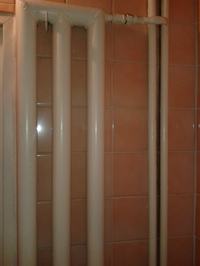During the renovation of the bathroom and the replacement of tiles, I wanted to replace the radiator with a new one. I have already talked to the cooperative about draining the water, the whole thing will be installed by a friend of mine, a plumber, but I would like to choose a good radiator and buy accessories in advance. The technical conditions provided by the cooperatives do not say anything about the pressure and temperature of the system, but only provide general information, e.g. that there is to be easy access, that the tiles on the floor are to be non-slip, etc. I called the heat allocator service - the number from the letter from the cooperative (in the bathroom there is no divisor) and the guy told me that I can assume what I want, because it is settled on the volume and not the divisor ... And I'm in the spot. In the photo I am enclosing the appearance of the current radiator. Radiator dimensions: 30x150, connections at the top and bottom.

As there are no allocators, I will want to install valves on the radiator (in case of future renovations). And here's a question for you:
1. What radiator can I install in this place? Is the ladder an option?
2. Where to get any data on an existing installation?
3. If I put, for example, a smaller heater, can I pull the tubes higher or lower than the central heating and everything will work as it should?
The apartment is on the 1st floor of a 4-story block.

As there are no allocators, I will want to install valves on the radiator (in case of future renovations). And here's a question for you:
1. What radiator can I install in this place? Is the ladder an option?
2. Where to get any data on an existing installation?
3. If I put, for example, a smaller heater, can I pull the tubes higher or lower than the central heating and everything will work as it should?
The apartment is on the 1st floor of a 4-story block.


